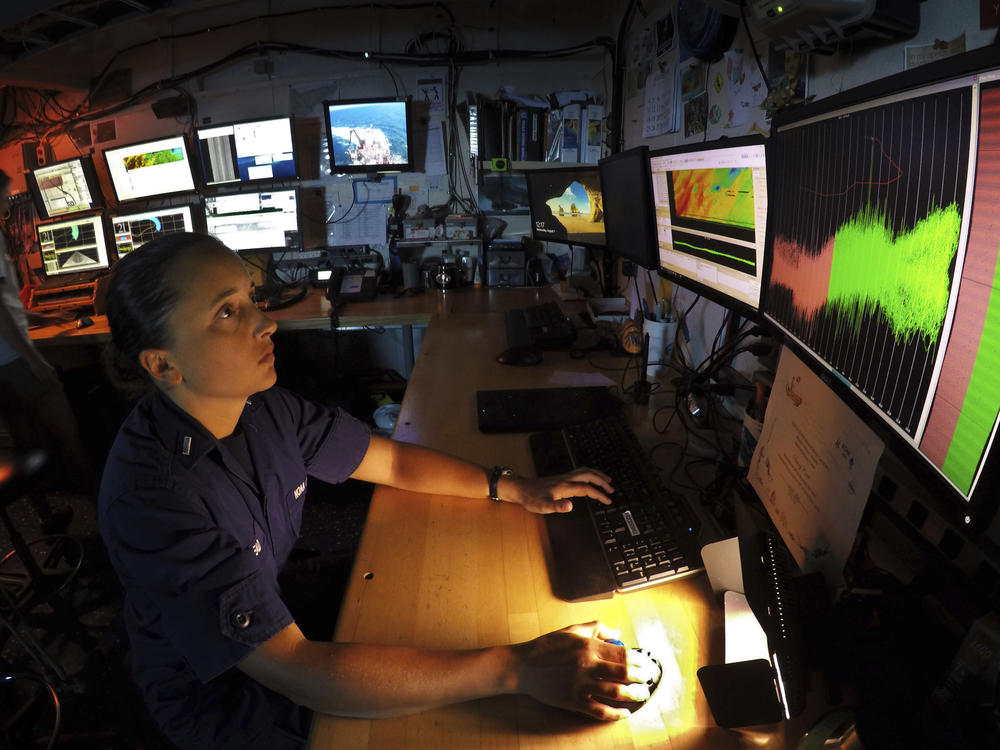Loading...
Section Branding
Header Content
Why Having Diverse Government Scientists Is Key To Dealing With Climate Change
Heard on
Primary Content
The Biden administration says addressing climate change and health inequities are among its top priorities, and it will need to lean heavily on federal scientists to achieve ambitious goals. But decades of underfunding, political interference and systemic race and gender bias have undercut trust among many government scientists and have led to a disproportionately white, male workforce.
Recent reports by the Government Accountability Office and House Committee on Science, Space and Technology found that the federal government has not done enough to recruit and retain scientists who are women and people of color. Moreover, opaque hiring practices coupled with successive government shutdowns, hiring freezes and outright political censorship have damaged the federal government's reputation among scientists, according to the GAO.
Many of the Biden administration's policy goals depend on a robust, stable and diverse scientific workforce. Reducing greenhouse gas emissions rapidly and equitably, as the federal government has promised, will require sweeping new policies that apply current understandings of pollution and atmospheric science. But past efforts to reduce pollution have disproportionately benefited people who live in whiter, richer parts of the country.
That history has led environmental and health experts to warn that new efforts to address climate change could deepen economic and health disparities rather than addressing them, especially if the people making policy decisions do not reflect the country's demographics.
"We must focus on revitalizing the federal scientific workforce and preparing it for future challenges," said Max Stier, the president of the Partnership for Public Service, a nonprofit that encourages young people to serve in government positions, at a hearing last month before the House science committee. "Altering the status quo will not be easy but it will be critical to the nation's future."
A trust problem
The federal government employs tens of thousands of scientists, engineers, mathematicians and economists. More than a dozen agencies, including the Environmental Protection Agency, NASA and the Department of Agriculture, rely on the sprawling federal technical workforce to develop policies and regulations about everything from health to food and space to pollution.
Many scientists who work for federal agencies serve under political appointees who are appointed by the White House. It wasn't always this way. For example, when the EPA was established in the 1970s, most of its research divisions were run by career civil servants, many of whom had scientific training.
The Reagan, Clinton and Bush administrations all added political appointees to scientific agencies, which meant more opportunities for political goals to affect how research is conducted and how scientific findings are, or are not, communicated to the public.
Dan Costa worked at the EPA for more than 30 years and retired in 2017 as the head of the agency's Air, Climate and Energy Research Program. He says the agency saw progressively less funding and more skepticism about scientific expertise in the decades he was there, but that the Trump administration went far beyond what had come before.
"It wasn't until the Trump administration came in that you felt this wave of — skepticism understates it," Costa says. "They didn't care about the science, they didn't care about health effects."
There were multiple high-profile instances of science censorship under the Trump administration. The president publicly attempted to personally revise a hurricane prediction, and agencies scuttled or delayed reports on chemical toxicity, air pollution and climate change.
Federal scientists also found their jobs were on the line in some cases. The Trump administration repeatedly asked Congress to cut budgets for health and climate research and relocated parts of the Departments of Interior and Agriculture out of Washington, D.C.
"We lost our experienced workers, we lost our midcareer people, we lost our junior staffing," says Laura Dodson, an agricultural economist at the USDA who helps lead Local 3403 of the AFGE federal employee union. "We've gone from being a mixture of experience to being a brand new, fledgling agency."
Costa says many young and midcareer technical employees at the EPA asked him for advice about how to handle the political interference. Young scientists must present at conferences and publish research to move up in their careers, and he remembers that the climate of censorship and budget cuts worried a lot of employees.
"In some cases I suggested to some people that they look elsewhere and move on," Costa says. "I didn't like doing that."
Some employees, like Costa, chose to leave or retire as a result of the political interference, although the total numbers were relatively small across all federal science agencies.
The EPA and Department of Energy both lost between 3% and 4% of their total workforce under the Trump administration, although the losses were in nontechnical jobs, according to the House Science Committee report. At the EPA, however, about 60% of those who left the agency under the Trump administration worked in scientific or technical roles, according to the report. An EPA spokesperson says the agency saw a net loss of 476 environmental protection specialists, who help oversee anti-pollution policies, and technical workers between 2016 and 2020.
During the same period, NASA and the National Oceanic and Atmospheric Administration, both key climate research agencies, both saw slight increases in the number of scientists, engineers and other technical employees.
But the combination of censorship and the ever-looming threat of budget cuts has taken a toll on how federal scientists feel about their jobs. A 2018 survey of about 63,000 scientists across the federal government found that morale had plummeted in many agencies compared to what it had been a decade earlier. At the EPA, for example, more than half of scientists surveyed that year said their morale was poor or extremely poor.
"We know how important the work we do is, and we've had to fight really hard over the past few years," says Dodson, of the USDA employee union. "We're just tired."
The Biden administration has already taken steps that could restore trust and build positive morale among federal technical employees.
The White House Office of Science and Technology Policy is investigating the potential for political interference in science at federal agencies and has asked more than a dozen agencies to submit information about how they preserve scientific integrity. EPA administrator Michael Regan took the extraordinary step of directing employees to contact the agency's inspector general if they have concerns about how science is used in the agency's policymaking. Regan is also replacing the members of two influential science advisory councils that came under scrutiny during the previous administration, in an effort to reassure agency employees and the public that the EPA is getting reliable scientific advice.
Many federal scientists welcome the changes. Andy Miller is the associate director for climate at the EPA's Air, Climate and Energy Research Program. He and his colleagues will be on the front lines of the administration's attempts to cut carbon emissions. The EPA regulates greenhouse gases and applies enormous amounts of federal climate research to regulations about air and water pollution.
"The science always wins," Miller says. "We just have a lot to catch up on."
Disproportionately white and male
The White House also says it wants to diversify the federal science workforce. The proposed infrastructure package would invest in colleges that serve minority students and universities that train young scientists and engineers.
Federal scientists are disproportionately white and male, a recent report by the House science committee found. While the percentage of women in technical positions has grown in the past decade, there is still a yawning gender gap at crucial science agencies. In 2020, only 27 of NOAA's 257 engineers were women.
"I had male mentors when I was in college and it did not go well," remembers Dodson, of the USDA. "I was discouraged from being a scientist and discouraged from taking my career further." She persisted and pursued a job in the federal government, in part because her father is in the same field.
The racial demographics among federal scientists are even more dismal. Among seven major federal science agencies, most employ two to three times as many white scientists as scientists of color, the House report found. Black scientists are the most underrepresented group. At the EPA, there's been a more than 20% decline in the number of Black technical employees over the past decade.
Recruiting and retaining Black scientists and other scientists of color begins at universities. "Students don't always know what they can do with their degrees. And the federal government, it can be a black box," says Antonio Baines, a toxicologist and pharmacologist at North Carolina Central University who has advised thousands of young scientists over the years.
North Carolina Central University is a historically Black institution, and its campus is just down the road from Research Triangle Park, which is a hub for federal laboratories including the EPA and National Institutes of Health. Baines has used that proximity to expose students to federal science jobs by inviting civil servants to guest lecture and helping students shadow or connect with government scientists in their chosen fields.
"I think for students, I think they're looking at what's going to offer them the most financial security, and what's going to offer them the best place for training and mentorship," says Baines. For some young scientists, the federal government can be a good fit.
A sense of pride
Having a role model who worked in the federal government can also draw young scientists of color to federal jobs. Computational biologist Tia Tate says one of her Ph.D. mentors had a postdoctoral position at a federal agency. "Knowing someone who had done a postdoc and was successful and well-trained through the program was comforting," Tate says, and that helped her decide to pursue her current postdoc position at the same science agency.
Tate can't discuss her work, but she says she's open to the idea of staying in government as long as she can work on the health disparities research that propelled her through her undergraduate and doctoral training. Tate received all of her advanced degrees from HBCUs.
"I feel like having graduated from these historically black colleges and universities has given me a sense of pride for myself and my people, and encouraged me to continue to do work for my community," she says.
But Tate also says it took her awhile to see a place for herself in government or academia as a scientist and a Black woman. "I felt like an imposter at one point," she says. "For me I think there was this hyper-awareness of stereotypes, this narrative that if you go to an HBCU your degree doesn't kind of equal up to those degrees at predominantly white institutions."
She and a group of other Black women in science and engineering fields founded a mentoring group called STEM Queens to encourage each other and push for more representation in the sciences.
"I had to continue to tell myself, you know, 'I am qualified. I'm not here just because of affirmative action.' I hate that term," Tate says. "And I had to lean on my circle of friends who were also dealing with those same things."
Tate says she's encouraged by what she's seeing in Washington, D.C.
Vice President Harris and at least one Cabinet member are graduates of HBCUs, and Tate feels that the federal government is increasingly open to diverse perspectives and research goals.
"I love being part of that narrative," she says. "A bunch of perspectives that weren't involved before are now being involved in decisions about health, public policy and social justice."
Copyright 2021 NPR. To see more, visit https://www.npr.org.



